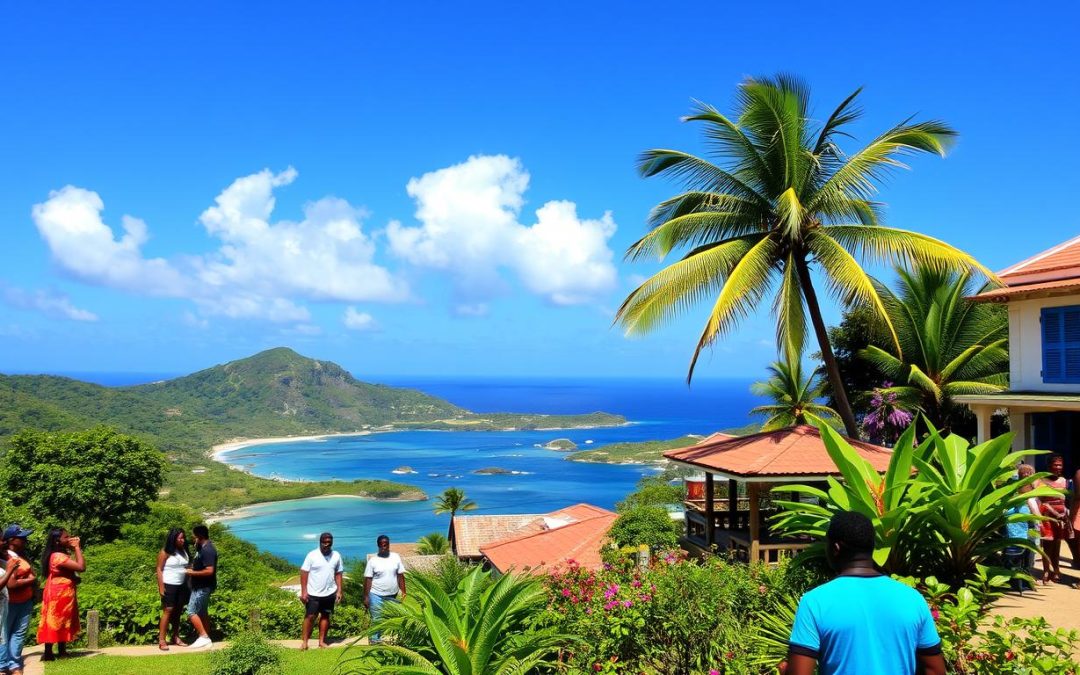Ever wondered how a small Caribbean island can speak many languages at once? In Guadeloupe, language diversity is more than just a feature—it’s a celebration of culture.
Located in the Caribbean, Guadeloupe has a unique language scene. French is the official language, but Creole is deeply rooted in the community. About 430,000 people speak Guadeloupean Creole, showing the island’s rich linguistic heritage.
Exploring Guadeloupe’s language world, you find a mix of official and local tongues. French is used in official places, schools, and government. But Creole is the heart of the island’s culture.
Key Takeaways
- French is the official language of Guadeloupe
- Approximately 430,000 residents speak Guadeloupean Creole
- Linguistic diversity reflects rich cultural history
- Urban population exceeds 98% of total residents
- Language represents more than communication—it’s cultural identity
Historical Evolution of Languages in Guadeloupe
Guadeloupe’s language history is a tale of cultural change. The Caribbean languages here show a mix of indigenous, colonial, and cultural influences. Before Europeans came, the islands were alive with the languages of indigenous peoples.
Pre-Colonial Indigenous Languages
The first people of Guadeloupe had their own languages. Two main groups were the Arawak and the Carib. Each had its own way of speaking.
- Arawak peoples with their intricate communication systems
- Carib tribes with distinctive linguistic practices
Impact of French Colonization
In 1635, French colonizers changed the islands’ languages. They brought French dialects like Picard, Norman, Poitou, and Saintonge.
- Picard dialect
- Norman language variations
- Poitou and Saintonge regional speech patterns
Development of Creole Language
The plantation system led to a new language – Guadeloupean Creole. It mixed French words with African grammar. This language showed the strength of African and French cultures.
“Language is the road map of a culture. It tells you where its people come from and where they are going.” – Rita Mae Brown
By 1946, when Guadeloupe became a French département, Creole was the main language. It showed the islands’ rich cultural mix.
French as the Official Language of Guadeloupe
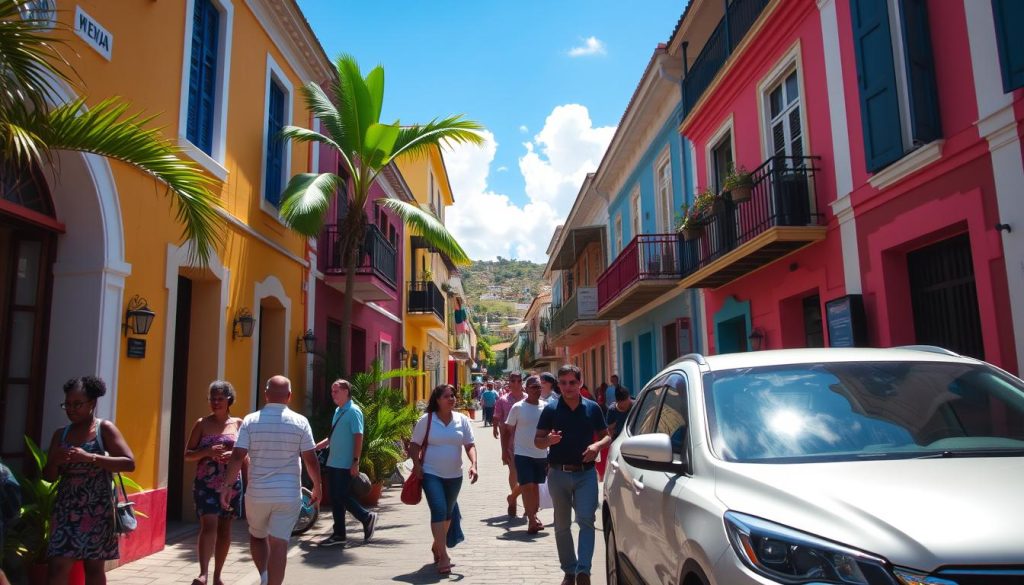
In Guadeloupe, French is the main language of everyday life. It’s key in government, schools, media, and talking to people. This language is everywhere in the archipelago.
The history of Guadeloupe shows how French became the main language. It came from colonial times and is now used for official talks and work.
- French is used in government administration
- All educational institutions conduct classes in French
- Media broadcasts are primarily in French
- Legal and business documentation is written in French
Even though French is the official language, people often speak Creole at home. This mix of languages shows the area’s rich culture.
“Language is the roadmap of a culture. It tells you where its people come from and where they are going.” – Rita Mae Brown
For visitors, knowing some French can really help. Most people are happy when you try to speak their language, even if you’re not perfect.
| Language Context | Usage Percentage |
|---|---|
| Official Government Communication | 100% |
| Educational Instruction | 95% |
| Media Broadcasts | 90% |
| Daily Informal Communication | 70% |
Learning French is important for anyone interested in Guadeloupe’s culture, language education, or work opportunities. This vibrant Caribbean region has a lot to offer.
The Rich Heritage of Guadeloupean Creole
Guadeloupean Creole is a vibrant language that shows the strength of cultural identity. It was born from the mix of history and culture. This language reflects the rich heritage of Guadeloupe.
Origins and Development
Creole started during the plantation era. It was a way for enslaved Africans and European colonizers to communicate. The language combines:
- French vocabulary
- African grammatical structures
- Influences from English and indigenous languages
Cultural Significance
For Guadeloupeans, Creole is more than a language. It’s a powerful way to express their cultural identity. It connects them to their ancestors and keeps their history and traditions alive.
“Creole is the soul of our community, speaking our history without words.”
Modern Usage
Today, Guadeloupean Creole is still alive and well in many areas:
- Daily conversations
- Local music and literature
- Media and entertainment
| Language Aspect | Percentage of Usage |
|---|---|
| Daily Spoken Creole | 85% |
| Media Representation | 65% |
| Artistic Expression | 75% |
With about 430,000 speakers, Guadeloupean Creole is key for keeping the language and culture alive.
Language Distribution Across the Islands
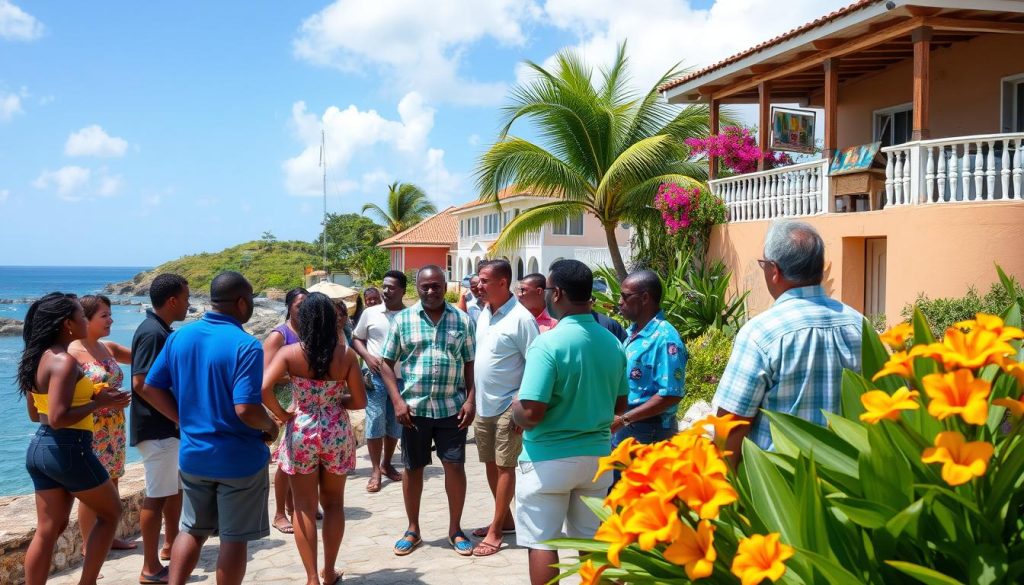
Guadeloupe’s language scene is a colorful mix of many languages across its six islands. Each island adds its own special touch to the area’s rich language mix. This creates a unique and interesting language world.
The archipelago has six main islands:
- Basse-Terre
- Grande-Terre
- Marie-Galante
- La Désirade
- Îles des Saintes (two islands)
Local dialects are key in how people talk across these islands. Guadeloupean Creole, with about 400,000 speakers, shows big differences between city and countryside. It shows the deep culture and history of the area.
“Language is the roadmap of a culture. It tells you where its people come from and where they are going.” – Rita Mae Brown
In cities like Pointe-à-Pitre, you’ll find a mix of French and Creole. But in rural areas, the traditional language is stronger. These dialects tell the story of Guadeloupe’s complex past.
But it’s not just about local talk. French is the official language, and English is growing in tourism and business. Knowing these languages helps us understand Guadeloupe’s culture deeply.
English Language Presence in Modern Guadeloupe
Guadeloupe’s language scene is changing, with English becoming more important in certain areas. The island, known for its international visitors, is seeing a shift in how people talk.
Tourism Industry Impact
English is key in Guadeloupe’s tourism world. Hotel staff and tour guides are learning to speak many languages. This makes it easier for visitors to communicate in English at:
- Hotels and resorts
- Tourism information centers
- Popular beach destinations
- Major restaurants and attractions
Business Communication
Guadeloupe’s businesses see the value of English for global trade. They focus on teaching English in areas like:
- Export industries
- Maritime services
- International consultancy
- Technology enterprises
Educational Settings
Schools in Guadeloupe are adding English to their curricula. This helps students get ready for the world. They learn to:
- Enhance career prospects
- Pursue international higher education
- Develop cross-cultural communication skills
“Language is the passport to a world of opportunities” – Unknown
Even though English is growing, French and Creole are still the main languages spoken in Guadeloupe. The island balances its global reach with respect for its local languages.
Language Education System in Guadeloupe
Guadeloupe’s language education system is a mix of many languages and cultures. It focuses on teaching both French and Creole. This approach helps students understand their cultural roots and learn to communicate globally.
Key aspects of the language education system include:
- French remains the primary language of instruction
- Creole has gained significant recognition in school curricula
- Bilingual education programs are increasingly implemented
The journey of language education in Guadeloupe has been transformative. In 1951, the Deixonne law first officially authorized regional languages in educational settings. A big step was made in 2002 with the creation of the Creole CAPES. This made Creole a part of the French education system.
| Education Milestone | Year |
|---|---|
| First Regional Language Introduction | 1945 |
| Deixonne Law Authorization | 1951 |
| Creole CAPES Establishment | 2002 |
Today, teachers work hard to make students bilingual. They use Creole to help students get better at French. This way, students keep their cultural identity while learning to communicate worldwide.
“Language is the roadmap of a culture. It tells you where its people come from and where they are going.” – Rita Mae Brown
Guadeloupe has a literacy rate of 90.1% and values language diversity. It keeps improving its language education. This blends old ways of communicating with new educational needs.
Cultural Identity Through Language
Language is at the heart of cultural identity in Guadeloupe. It tells a story of resilience and expression. Understanding Caribbean languages shows a deep bond between words and heritage.
Linguistic Traditions
Guadeloupean Creole is a symbol of cultural preservation. About 80% of the people speak Kreyòl. This language is more than just talking; it’s a living history of the island.
- Oral storytelling traditions
- Music and poetry expressions
- Intergenerational knowledge transfer
Social Impact
Preserving language in Guadeloupe is more than keeping words alive. It’s about keeping culture alive. Kreyòl connects generations and communities.
“Language is the roadmap of a culture. It tells you where its people come from and where they are going.” – Rita Mae Brown
Community Expression
The link between language and society is interesting. About 58% of Guadeloupeans see Kreyòl as key to their identity. It shapes how they interact and connect with each other.
| Language Aspect | Cultural Significance |
|---|---|
| Kreyòl Usage | 80% Population Engagement |
| Cultural Identity Marker | 58% Population Connection |
| Language Advocacy | 75% Support Recognition |
Exploring Guadeloupe’s language shows how it’s more than talking. It’s a powerful way to express and preserve culture.
Language Preservation Efforts
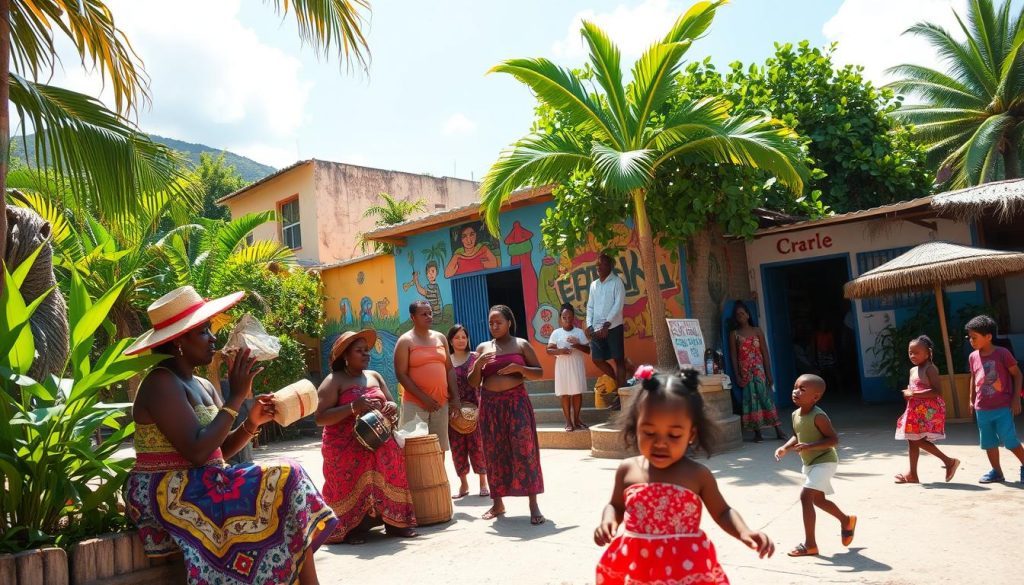
Guadeloupe is working hard to save its unique culture. They focus on Creole, seeing it as a vital part of their identity. It’s not just a way to talk; it’s a treasure that keeps their culture alive.
They’re using several ways to keep Creole safe:
- They’re making detailed records of the Creole language.
- They’re creating learning materials for schools.
- They’re holding workshops in communities to teach Creole.
- They’re helping older people teach younger ones to speak Creole.
Local groups are fighting against old beliefs that made Creole seem less important. They want to make it more respected and get younger people interested in their language.
“Language is the roadmap of a culture. It tells you where its people come from and where they are going.” – Rita Mae Brown
Technology is helping a lot in saving Creole. Websites, apps, and social media are used to share and promote the language. This makes sure Creole is seen in today’s digital world.
Schools play a big role in saving Creole. They’re adding it to the curriculum. This helps keep the culture and language alive.
- 12 million people speak Haitian Creole globally
- Guadeloupe is at the forefront of Creole language preservation
By saving Creole, Guadeloupe is protecting a key part of its culture. It’s not just a language; it’s a heritage for the future.
Multilingualism in Daily Life
Guadeloupe is a place where many languages blend together smoothly. This shows how rich and diverse the culture is. It’s not just about talking; it’s about sharing stories and traditions.
In Guadeloupe, the way people speak changes a lot depending on where they are. In cities, French is often used for official talks. But in rural areas, Guadeloupean Creole is more common.
Urban Language Dynamics
In cities, you see a lot of different languages being used. People switch between:
- French (official language)
- Guadeloupean Creole
- Occasional English in tourism sectors
- Regional dialects with unique linguistic characteristics
Generational Language Preferences
Younger people in Guadeloupe are getting better at speaking two languages. They use French more in work and keep Creole close to their hearts.
- Increased bilingual proficiency
- Growing comfort with French in professional settings
- Preservation of Creole as a cultural marker
“Language is the roadmap of a culture. It tells you where its people come from and where they are going.” – Rita Mae Brown
About half of the people in Guadeloupe speak both French and Guadeloupean Creole every day. This shows how special the place is, where talking is more than words.
The mix of languages in Guadeloupe is not just about talking. It’s about showing who we are, connecting with others, and keeping our history alive.
Communication Challenges and Solutions
Guadeloupe’s language scene is complex, making communication tough. The mix of French, Creole, and other dialects needs new ways to connect. This is key for effective communication.
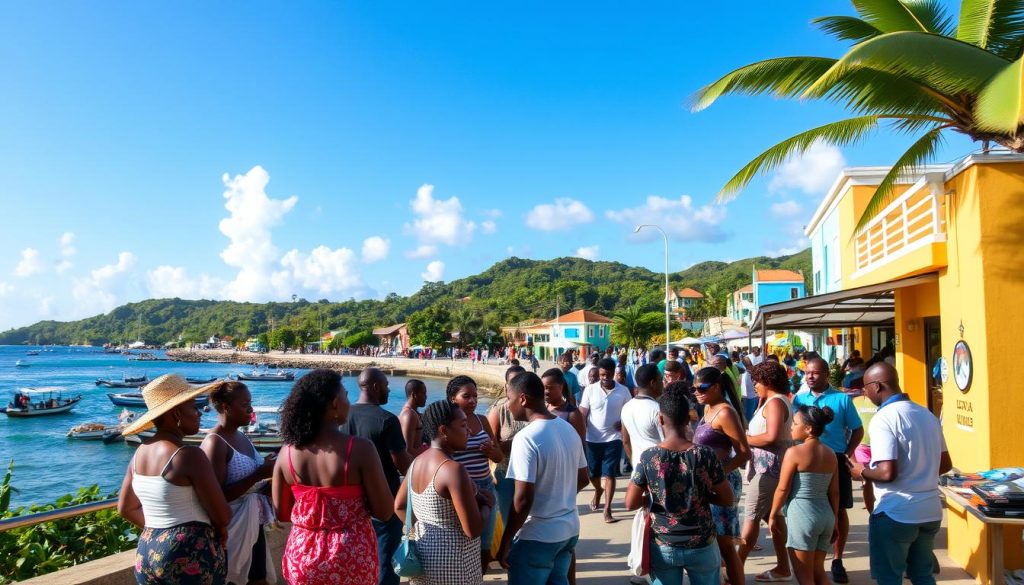
- Language barriers in public services
- Educational communication gaps
- Healthcare interpretation difficulties
- Tourist interaction complexities
Local leaders have come up with creative fixes. They’ve started language education programs. These programs aim to:
- Train service workers to speak multiple languages
- Use new translation tech
- Teach cultural understanding
- Start community language exchange groups
“Communication is the bridge that connects diverse linguistic communities” – Local Language Preservation Expert
Technology is a big help in breaking language barriers. Apps, real-time translation, and online learning tools are changing how we talk in Guadeloupe.
The aim is to make a place where all languages can live together. This supports both local culture and global communication.
The Future of Languages in Guadeloupe
Guadeloupe is at a key moment for language and culture. There are about 400,000 Creole speakers on the islands and 200,000 more living abroad. This change is big for the language scene.
New plans for multilingualism in Guadeloupe are exciting. The CIGAREL project, backed by the Regional Council, aims to boost language skills. It focuses on English, Spanish, and French training at a new centre.
“Language is the roadmap of a culture. It tells you where its people come from and where they are going.” – Rita Mae Brown
Key Trends in Language Evolution
- Increasing recognition of Guadeloupean Creole’s cultural significance
- Growing educational programs supporting multilingual skills
- Digital technology enabling language preservation
- Enhanced international collaboration in language learning
The language scene in the Caribbean is changing. Most Guadeloupeans speak French and Kréyòl. There are three main trends: keeping the language alive, it getting weaker, or being replaced.
New plans in education and culture want to keep Guadeloupean Creole strong. This is a big step for keeping our culture and language alive for the next generations.
Conclusion
Guadeloupe is a vibrant example of how language diversity enriches culture. Your exploration of the islands shows a mix of French, Creole, and more. This mix is not just about talking; it’s a living part of their cultural identity.
Learning about Guadeloupe’s languages is more than just words. It’s about seeing how language ties communities, keeps history alive, and links families. French and Guadeloupean Creole show how languages can thrive in this Caribbean place.
As the world changes, Guadeloupe keeps its language traditions alive. Your interest in this diversity helps keep their stories and culture alive for others. The islands show that language is more than talking; it’s a deep way to share our experiences and keep our cultures alive.
If you love languages, cultures, or just exploring, Guadeloupe has a lot to offer. It teaches us that every language is full of meaning, connection, and identity. There’s so much to discover in the world of languages.
The above is subject to change.
Check back often to TRAVEL.COM for the latest travel tips and deals.
Here are some Tours & Sightseeing suggestions that might pique your interests!
